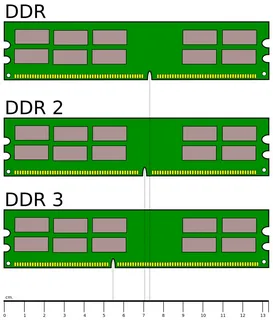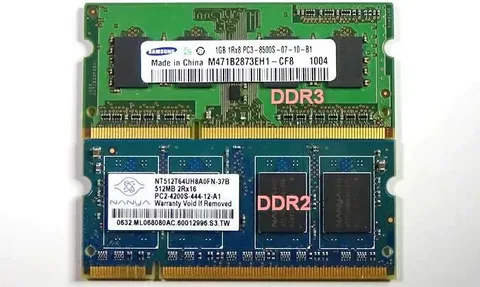Explore the differences between DDR vs. DDR2 RAM, including their uses, advantages, disadvantages, cost, and key features. Understand how DDR and DDR2 RAM work.
When it comes to upgrading or building a computer, understanding the types of RAM (Random Access Memory) available is crucial. Two of the early contenders in the RAM world are DDR (Double Data Rate) and DDR2 RAM. Both have significantly impacted computer performance, but what exactly sets them apart? Let’s dive deep into the world of DDR vs. DDR2 RAM, exploring their key features, uses, advantages, and disadvantages. We’ll also tackle their cost, current status in the tech market, and answer some frequently asked questions. Buckle up!
What is DDR vs. DDR2 RAM?
DDR RAM
DDR RAM, or Double Data Rate Random Access Memory, was a game-changer when it was first introduced. Unlike its predecessor, SDRAM (Synchronous Dynamic Random Access Memory), DDR RAM could transfer data twice per clock cycle—on both the rising and falling edges of the clock signal. This effectively doubled the data throughput, making systems faster and more efficient.
DDR2 RAM
Building on the success of DDR, DDR2 RAM brought further enhancements. It operates at a higher clock speed and offers better performance with reduced power consumption. DDR2 RAM achieved this by doubling the prefetch buffer size from 2 bits (in DDR) to 4 bits, allowing it to fetch twice the data per clock cycle. This innovation improved overall system performance and energy efficiency.

How DDR vs. DDR2 RAM is Used
In Everyday Computing
Both DDR and DDR2 RAM have been integral in everyday computing tasks. From running basic applications to managing multitasking environments, these RAM types have ensured smooth operation and responsive user experiences.
In Gaming
Gamers require high-speed memory to handle the intensive graphics and processing demands of modern games. DDR RAM, in its time, supported the needs of early gamers. However, DDR2 RAM, with its higher bandwidth and improved latency, offered even better performance, making it a popular choice for gaming rigs during its era.
In Servers and Workstations
Servers and workstations benefit immensely from higher RAM speeds and capacities. DDR and DDR2 RAM have both been employed in such environments to enhance data processing capabilities and ensure reliable performance under heavy workloads.
Battery
Although DDR and DDR2 RAM are primarily associated with desktop and laptop computers, where battery life is a consideration, it’s important to note how each type impacts power consumption. DDR2 RAM was designed to consume less power than DDR RAM, making it more suitable for battery-operated devices like laptops. This reduction in power usage not only extended battery life but also reduced heat generation, contributing to overall device efficiency.
Status
DDR RAM
Today, DDR RAM is considered obsolete. It’s no longer produced or supported by modern motherboards and systems. However, it still finds use in some legacy systems and specialized applications where older hardware is maintained.
DDR2 RAM
While DDR2 RAM is also largely outdated, it has a slightly longer lifespan in terms of usability compared to DDR RAM. It can still be found in older systems and servers that haven’t been upgraded to newer RAM technologies. However, for new builds, DDR2 RAM is not recommended.
Key Features
Let’s break down the key features of DDR vs. DDR2 RAM in a handy table:
| Feature | DDR RAM | DDR2 RAM |
|---|---|---|
| Clock Speed | 200-400 MHz | 400-1066 MHz |
| Data Rate | 400-800 MT/s | 800-2133 MT/s |
| Voltage | 2.5V | 1.8V |
| Prefetch Buffer | 2 bits | 4 bits |
| Latency | Lower | Higher |
| Power Consumption | Higher | Lower |
| Maximum Capacity | Limited | Higher |
Advantages
DDR RAM
- Cost-Effective: During its prime, DDR RAM was relatively affordable.
- Increased Performance Over SDRAM: Provided a significant performance boost compared to SDRAM.
DDR2 RAM
- Higher Speed: Operates at higher clock speeds, improving data transfer rates.
- Lower Power Consumption: Consumes less power, ideal for battery-operated devices.
- Increased Capacity: Supports higher memory capacities, making it suitable for more demanding applications.
Disadvantages
DDR RAM
- Power Consumption: Higher power consumption compared to newer RAM technologies.
- Obsolete: No longer supported by modern hardware.
DDR2 RAM
- Higher Latency: Though faster, it has higher latency compared to DDR RAM.
- Compatibility Issues: Not compatible with DDR and DDR3 slots, limiting upgrade options.
Cost
When it comes to cost, it’s essential to consider both historical and current perspectives.
Historical Cost
During their respective peaks, DDR and DDR2 RAM were priced based on their performance improvements and manufacturing costs. DDR RAM was cheaper to produce initially, but as DDR2 RAM technology matured, it offered better value due to improved performance and efficiency.
Current Cost
Today, both DDR and DDR2 RAM are considered legacy technology. This means they can be hard to find and may be more expensive due to their rarity. However, for those maintaining older systems, acquiring second-hand or refurbished modules can be a cost-effective solution.
Conclusion
In the battle of DDR vs. DDR2 RAM, it’s clear that both have their place in the evolution of computer memory. DDR RAM was a revolutionary step from SDRAM, while DDR2 RAM built upon this foundation to offer better performance and efficiency. Though both are now outdated, understanding their differences and historical significance helps appreciate the advancements in RAM technology that followed. As we continue to see newer generations like DDR3, DDR4, and now DDR5, the legacy of DDR and DDR2 RAM remains a testament to the rapid pace of technological innovation.
FAQs
What is the primary difference between DDR and DDR2 RAM?
The primary difference lies in their data transfer rates and power consumption. DDR2 RAM offers higher speeds and lower power consumption compared to DDR RAM.
Can I use DDR2 RAM in a DDR slot?
No, DDR2 RAM is not compatible with DDR slots due to different pin configurations and electrical requirements.
Is DDR2 RAM still available for purchase?
Yes, but it is mostly found as second-hand or refurbished modules since it is no longer in production.
Why did DDR2 RAM replace DDR RAM?
DDR2 RAM replaced DDR RAM because it provided better performance, higher data rates, and improved power efficiency.
How does the prefetch buffer size impact performance?
A larger prefetch buffer allows the RAM to fetch more data per clock cycle, improving overall data transfer rates and system performance.
What are the voltage requirements for DDR vs. DDR2 RAM?
DDR RAM typically operates at 2.5V, while DDR2 RAM operates at a lower 1.8V, contributing to its reduced power consumption.
Which is better for gaming: DDR or DDR2 RAM?
During their respective times, DDR2 RAM was better for gaming due to its higher speeds and improved performance.
Can modern motherboards support DDR or DDR2 RAM?
Most modern motherboards do not support DDR or DDR2 RAM as they are designed for newer RAM technologies like DDR3, DDR4, and DDR5.
What should I consider when upgrading RAM?
When upgrading RAM, consider compatibility with your motherboard, the required speed, capacity, and whether it meets your performance needs.
Is there a significant performance difference between DDR and DDR2 RAM?
Yes, DDR2 RAM offers higher clock speeds and better performance compared to DDR RAM.
For More Information, Visit https://technoworldhub.com/

